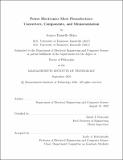Power Electronics Meet Piezoelectrics: Converters, Components, and Miniaturization
Author(s)
Boles, Jessica Danielle
DownloadThesis PDF (20.53Mb)
Advisor
Perreault, David J.
Terms of use
Metadata
Show full item recordAbstract
As converters and controllers of electrical energy, power electronics are the lifeblood of many exciting emerging technologies in transportation, manufacturing, information technology, and more. However, while integrated circuits have seen miniaturization and expanded performance characterized by Moore’s Law, power electronics often remain the bulkiest, lossiest, and costliest components in the systems they serve. Miniaturization of power electronics is fundamentally bottlenecked by passive components, particularly magnetics (i.e., inductors and transformers), which pose inherent size and performance challenges at small scales.
This thesis explores how we can leverage an alternative passive component technology – piezoelectric components – to eliminate magnetics and unlock a new era of miniaturization for power electronics. Piezoelectrics offer several potential size, performance, and manufacturability advantages to power electronics, but harnessing these advantages requires fundamental re-evaluation of both power electronic circuits and piezoelectric components themselves. Accordingly, this thesis presents the following recent advances: (1) Dc-dc converter circuit topologies and operating sequences capable of efficiently utilizing piezoelectrics as sole passive components; these converter implementations demonstrate the efficiency viability of piezoelectric-based power electronics and provide their highest experimental efficiencies to date. (2) Piezoelectric component design tools for efficiency and power handling density; this framework enables maximal utilization of piezoelectric components and reveals them to have favorable scaling characteristics to small sizes. (3) An experimental demonstration of dramatic miniaturization offered by piezoelectrics; this prototype piezoelectric component has nearly an order of magnitude lower volume than a competing magnetic component design.
These are important steps in realizing the theoretical advantages of piezoelectrics in power electronics, positioning them to revolutionize what is possible for computing, wireless communication, robotics, biomedical devices, renewable energy, and beyond.
Date issued
2022-09Department
Massachusetts Institute of Technology. Department of Electrical Engineering and Computer SciencePublisher
Massachusetts Institute of Technology